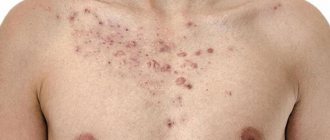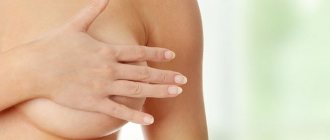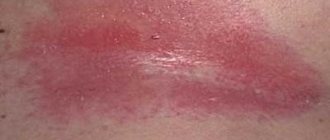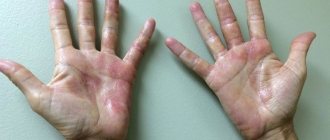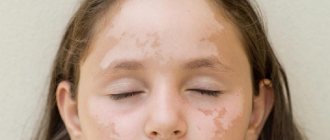White dots on the nipples are a common phenomenon, which may be a consequence of hormonal imbalance or the development of gynecological or dermatological pathology.
It is not uncommon for the symptom to occur during pregnancy and lactation. Treatment is prescribed taking into account the source of the rash.
What are the white dots in the nipple area?
White dots can be:
- single or multiple;
- filled with or without content;
- located around the areolas or on the nipples themselves.
Usually, white dots do not appear “in their pure form” on the nipple, areola or around it, but rather flat whitish formations. More often these are tubercles, nodules or pustules.
Spots also appear on the nipples, for example, with uneven coloring of the SAC area (nipple and areola combined). And then small white dots or quite visible spots are scattered across the pink areola. This cosmetic defect can be easily corrected with tattooing.
Flat formations include vitiligo (disappearance of pigmentation). It is the nipples that this disease rarely affects, but the phenomenon is not excluded. In some articles, vitiligo is described as Fordyce granules, but this is not so; we will talk about the granules below.
Is treatment required?
Do I need to take any therapeutic measures if my nipples have turned white? The specifics of the therapeutic intervention depend on what exactly provoked the abnormal phenomenon.
If the reason is the presence of some disease in the female body, then the doctor prescribes a treatment regimen that is practiced for this disease:
| State | Features of treatment |
| Thrush | Treatment of thrush is based on an integrated approach. Recommended medications for oral and external use: Miconazole ointment, Candide cream, Nizoral cream, Nystatin ointment, Fluconazole. |
| Additional remedies include: - green tea (suppresses the activity of Candida fungus); - washing the nipples and areolas with a soda solution (1 tsp soda per glass of boiled water); - compresses with vinegar. (add 1 tsp of apple cider vinegar to 100 ml of boiled water. Soak gauze in the solution and apply to the problem area); - exclusion of sweets and foods with yeast from the diet. | |
| Raynaud's syndrome | Therapeutic measures are prescribed (breast massage, air baths, rubbing the skin with oils, etc.). |
| Taking vitamin B6 complex with niacin. Treatment regimen: 100 mg twice daily for several weeks. | |
| Taking Nifedipine. The remedy is prescribed if the methods described above are ineffective. Dosage – 1 tablet per day. The duration of the treatment course is 2 weeks. | |
| Milk stagnation during breastfeeding | In this situation, it is recommended to put the baby to the breast as often as possible so that his chin rests on the area of the plug. Self-massage of the breast is also recommended. If a woman is unable to resolve the problem on her own, she should contact a lactation consultant or mammologist. |
| Vitiligo | Often medications are prescribed that affect the synthesis of melanin and improve metabolic processes in the body, vitamin therapy, and hormonal agents. A good effect is achieved with ultraviolet irradiation, as well as after completing a course of PUVA therapy. |
| Fordyce granules | There are no effective treatments. Basically, the disease disappears on its own by the age of 40. Itchy discomfort can be eliminated through laser correction. |
Additionally, a woman should follow all medical recommendations:
- After feeding, immediately cover your breasts with a warm, damp towel.
- After taking a shower, you should also cover your bust to prevent cold air from entering.
- If a burning sensation is felt, you need to create conditions for an additional flow of blood to the nipple. Olive oil helps a lot in this regard. Take some oily liquid, warm it between your fingers and massage your nipples. This massage significantly reduces pain.
- Dry applications. After feeding, lie down and apply warm heating pads to the areola-nipple area for a few minutes.
- Vitamin therapy.
- Intensive massage of the chest (the area between the collarbone and mammary glands), while the breast itself is not affected.
- Gentle massage of the muscles under the breasts and armpits.
Cosmetic treatment method
In the absence of pathological conditions, when the whitening of the nipples is caused by natural causes, their color can be improved with the help of tattooing.
Cosmetic nipple dyeing is the introduction of a colored pigment under the skin of the areola. The tattoo itself is performed in several stages, using different types of techniques using several pigment substances, thereby achieving their uniform distribution in the tissues of the areolar-nipple area.
Immediately before the procedure itself, the patient receives recommendations about possible contraindications and nipple care in the post-procedure period.
Nipple dyeing technique;
- Anesthesia is performed with a special cream (injections are not practiced in tattooing due to excessive sensitivity of the chest area).
- The introduction of hypoallergenic dyes is carried out with a special device with one or three needles.
- Next, the pigment is shaded or the contour version of the parchment is saved.
- The duration of the correction is approximately an hour.
- The area of the nipples and areola is smeared with cream and covered with cling film for 4-6 hours.
Further care is the same as with other types of tattooing: application of wound-healing agents, antibacterial procedures, avoidance of sunlight on the skin.
The cosmetic effect lasts for an average of 5 years, but experts recommend correction every 2-2.5 years.
Causes of whitish spots
The appearance of whitish spots is associated with the period of bearing and feeding the baby. But this phenomenon can occur in a non-breastfeeding woman, for example, before menstruation, as well as in a man or child.
Traditionally, the reasons for the appearance of white pinpoint formations in the area of the SAH include:
- bacterial infection (strepto- and staphylococcal);
- hormonal imbalances (occurs in adolescents, women during pregnancy and in people with hormonal stress);
- endocrine diseases.
But, as we have already seen, this may be a pigmentation disorder, and also:
- Seborrheic cysts (more correctly, sebaceous gland cysts) or Fordyce granules.
- Infestation with the fungus Candida.
- Enlargement of the Montgomery tubercles during pregnancy. If tubercles appear around the areola during pregnancy, these are most likely enlarged Montgomery glands (tubercles). This is a normal phenomenon and can be considered one of the signs of successful conception. Although this phenomenon is not observed in all pregnant women.
- Blockage of the milk ducts of the nipple during breastfeeding (breastfeeding). It occurs when the baby is not properly applied (the baby does not suck milk from all ducts), when there is excessive intake of calcium into the mother’s body, hyperlactation, or prolongation of the intervals between feedings.
Having seen how many reasons lead to the appearance of white dots, you will want to know which one is yours. The most competent decision is to consult a doctor. But we will talk about additional symptoms accompanying each of the causes.
When not to worry
If the appearance of white dots is not accompanied by unpleasant sensations, there is no need to worry. Here are the main reasons for the formation of such rashes.
Montgomery gland blockage
Montgomery's glands are modified sebaceous glands located around the nipple. They are tubercles of the same color as the areola. These structures are necessary to moisturize the nipple area and protect it from bacteria. During pregnancy and lactation, the glands increase in size and sometimes secrete milk and colostrum. The ducts can become clogged, which is why white spots form on the nipple areola. Treatment in this case is not required. But if there is pain and burning, then inflammation has begun. In this case, it is necessary to contact a mammologist or gynecologist as soon as possible, otherwise the infection will penetrate deeper and spread to the mammary gland.
Colostrum
The secretion of the mammary gland, which is secreted in the last days of pregnancy and at the beginning of lactation. It is a thick substance with a yellowish tint and a specific odor. It leaves a coating on the nipples, which is removed with water. But after cleansing, white spots soon appear again. Within a week, colostrum turns into regular milk, and the problem disappears by itself. Sometimes secretions clog the ducts, causing chest pain. In this case, consultation with your doctor is necessary.
Fordyce granules
They are also called “seborrheic cysts.” This sounds scarier than it actually is. These are just clogged sebaceous glands. Blockage occurs due to the abnormal location of the glands and a large amount of secretion. Most often, the problem occurs due to hormonal changes during adolescence, pregnancy or menopause. Also, tubercles form after ovulation, which is why white dots appear on the nipples before menstruation. The granules are small whitish compactions. If you press on them, a white or yellowish plug comes out. But squeezing out cysts is not recommended. This is fraught with infection. Neoplasms go away on their own over time. Defects are also removed in a cosmetology clinic with liquid nitrogen, laser or electric current.
Acrofacial vitiligo
Vitiligo is a disease characterized by the destruction of the skin pigment melanin. The causes of the pathology are not fully understood. It is believed that its occurrence is influenced by a combination of neurogenic, immune and hormonal disorders. Sometimes depigmentation is formed due to damage by components of drugs and chemicals, and appears after the resolution of purulent inflammation. The acrofacial form of the disease is characterized by the appearance of white spots on the nipples, lips, fingertips, and skin around the mouth. The disease is not life-threatening, does not cause physical discomfort and is unpleasant only from an aesthetic point of view. It is very difficult to get rid of defects. To restore pigmentation, dosed UV radiation or artificial addition of melanin is used. Antioxidants and immunomodulators are prescribed as medications.
Signs of whitish formations in the area of SAH
| Cause | Additional signs |
| Uneven pigmentation of the nipple | No |
| Vitiligo | A contour rim (zone of hyperpigmentation) around the lesion. Dyschromia on other parts of the body. |
| Bacteria | Purulent contents of a white spot. When acne appears in men, women and teenagers, one pimple (including exclusively on the nipple) or many whiteheads may form. |
| Fordyce granules | Itching and burning. In women, increased discomfort before and during menstruation (this is a characteristic sign of pathology). Long-term course (over 10 years). |
| Candidiasis | Whitish coating in the affected area. Itching and burning of the SAH area. Pain during hepatitis B. Erosions and ulcers, maceration (softening and separation of skin fibers). Hyperemia around the SAH. In non-breastfeeding women, signs of candidiasis intensify before menstruation. Why? Because sex hormones, rampant during this period, stimulate the growth of the fungus. |
| Montgomery tubercles | No |
| Blockage of the milk ducts during breastfeeding (lactostasis) | With lactostasis: Feeling of fullness in the chest. Pain when feeding. Slight redness of the breast skin in the area of the blockage. Lumps in the mammary gland. With the development of mastitis: high body temperature; severe discomfort; sharp jerking pain; severe redness on the skin over the site of stagnation; signs of intoxication (headache, weakness, nausea). |
Is this condition dangerous?
As you can see, nipples can turn white not only due to a woman having some kind of disease. The condition of the breast may be determined by the individual characteristics of the body.
Whether or not you need to see a doctor depends on the situation and the symptoms you are experiencing. If a woman is not worried about anything and feels consistently good, a visit to the doctor’s office can be postponed until a scheduled visit to a mammologist.
However, if unusual and painful symptoms occur and the woman is pregnant or breastfeeding, a specialist should be consulted.
You should especially seek help immediately if you experience:
- White film on nipples.
- White plaque in the baby's mouth.
- Breast tenderness.
- Manifestation of sharp pain radiating deep into the gland.
- The formation of poorly healing cracks in the nipples.
- Increased body temperature.
- The appearance of discharge from the nipple of an unnatural color.
- Pain occurs in only one breast.
- Only one nipple turned sharply white.
- Swelling of the mammary glands.
Blockage of the milk ducts during lactation requires immediate removal of the plug, due to which the milk cannot come out. Exacerbation of the situation is dangerous with inflammation of the mammary gland and other serious complications.
Treatment of white spots on the areola and nipple
Treatment for white spots in the area of SAH depends on the cause of the change. For example, uneven coloration of the nipple is corrected in a tattoo parlor. Enlarged Montgomery tubercles cannot be treated in any way. For candidiasis, specific therapy is carried out with antimycotics: locally (nystatin ointment, candida solution) or systemic drugs Defflucan once (consultation with a doctor is required!).
Fordyce granules are removed using laser or cryocorrection. Prevent by applying Retin-A cream and jojoba oil. For purulent infections, pimples are treated with local antiseptics and antibiotics in the form of a cream.
With lactostasis, the breasts are strained, before feeding, take a warm shower or cover the bust with an ironed towel, and adjust the feeding regimen. For purulent mastitis, surgery is indicated.
This concludes our review of the topic, says goodbye to you and invites you to visit our site again. We will be glad if you subscribe to our newsletter and invite your friends and acquaintances to our site.
What to do
The problem should be dealt with by a qualified doctor. Taking antibiotics helps stop inflammation. Additional immunostimulants and sedatives are prescribed. In some cases, it is recommended to steam and massage the breasts. Hormonal correction also helps get rid of spots. Treatment with drugs is carried out under the supervision of physicians.
If stains and irritation are due to improperly fitted underwear, you should change your bra. The product is selected according to its size. The bra should support the bust and not tighten it.
It is important to remember that redness may be due to heat rash. The glands should be washed with warm water daily. Taking a shower will help wash away accumulated sweat and prevent the proliferation of bacterial flora. Water procedures must be carried out without the use of soap, which can irritate the delicate nipple and cause allergies. You need to take care of your mammary glands every day.
Lipoma
A benign tumor in the subcutaneous fat. It is a soft round or oval capsule that moves easily when pressed. Appears due to blockage of the sebaceous gland duct, hormonal or metabolic disorders, or breast injury. If a lump near the nipple in women is a lipoma, then there may be no associated symptoms. With large tumors, the breast changes shape, and discomfort is felt when you press on the affected area. A tumor is removed if it is growing rapidly, affecting surrounding tissue, or if there is a family history of lipoma degeneration into cancer. In other cases, medical observation and treatment of concomitant diseases are indicated.
Blocked pores or ducts
Nipple pores are the exit openings of the ducts leading to the mammary glands of a woman's breast, where milk is stored.
When a woman breastfeeds her baby, the nipple pores and ducts sometimes become clogged or blocked by milk. Symptoms and treatment for this condition may vary depending on the length of time the pores remain blocked.
Symptoms
Blocked Pores
Any changes in the shape, color and size of the nipples should be assessed by a doctor
When the pores first become blocked, white spots may appear on the nipples. They are also called bubbles.
Blocked pores can be painful, but in most cases they will clear up during your baby's next feeding.
Milk blisters
If the skin grows and closes the openings of blocked milk pores, blisters can form on the breasts. The area around the white spots in such cases often becomes red and inflamed.
Blocked ducts
When nipple pores remain blocked, the milk ducts leading to the glands may also become blocked and inflamed.
Lumps and swelling often occur under blocked nipple pores. In such cases, the pain intensifies and breastfeeding the baby causes significant discomfort to the woman.
If you do not seek prompt medical attention, blocked milk ducts can lead to complications such as mastitis or breast abscesses.
Treatment
Blocked nipple pores often clear naturally during breastfeeding.
When the pores do not clear on their own, a woman should help herself with the following steps:
- place a warm compress on the breasts and nipples before feeding;
- use a cold compress after feeding to reduce discomfort;
- take a warm shower and gently rub blocked nipples with a towel;
- massage the breast and nipple, but this must be done gently, since sensitive breast tissue can be easily damaged;
- express milk before feeding to soften the breasts;
- when feeding, give the baby the affected breast first;
- when feeding, place the baby’s lower jaw near the bump, which is caused by a blocked duct;
- use painkillers such as paracetamol or ibuprofen to relieve pain.
